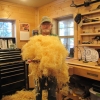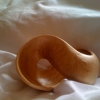A dory drawn up on a quiet beach. Summer rowing in Maine...
Although the subject - the dory, or rowing boat - might seem simple, from a carving point of view there are some interesting challenges in this relief: in particular the perspective. The elegantly shaped boat sweeps back at an angle into the picture; the prow lies at the original wood surface and the stern is outlined against the far background. Then we have rocks, sea and sky to consider. As with all true relief carvings, there is only one viewpoint that 'works', and all you have to play with here is depth, and we need to fully use it.
In this lesson, I look at preparation. You know that, 'Fail to prepare and prepare to fail'? It's true! I used Elm wood, though any good carving wood will do.
The precise dimensions of my starting block was: Length (along the grain): 450mm (17 3/4in.) x Width: 275mm (10 7/8in. x Thickness: 50mm (2in.)
For subscribing members, below is my working drawing and tool list (as a pdf) of the Coastal Relief carving, with a scale.

| 28 May 2019 08:30
Jim - It's a good question. After all, Wood is the third leg of what I call the carver's 3-legged stool (the others being Tools and techniques, and Design).
We do have videos on selecting wood (search 'wood', or Carving Matters > Wood Selection > Introducing Wood). There are differences in how would behaves and moves, both in the way it is cut and the type of wood, and that affects how you plan your relief carving or glue up.
Have a look at these and if you think there is something we haven't covered, or could cover better, write to us, info@woodcarvingworkshops.tv, and I'll look at filling out what we have here. It's certainly a topic we could visit more and give some definitive guidance rather than general information.
As for the Elm, that's not been my experience. What does seem to matter is whether wood is air or kiln dried, with the kiln dry wood being harder and more brittle. Hope this helps!

| 26 May 2019 15:43
Chris, on selecting wood could you explain the different cuts of wood such as quarter, plain and rift sawn. And what would be the best for carving? I noticed that you have a piece of plain or flat sawn. It's a cheaper cut but it has a greater chance to warp or twist. I read that elm when cut Quarter sawn is more difficult to work with. Does it make a difference in the cut of wood for carving? And if so what is the most desirable to get? Or does it depend on what type of wood it is? Maybe you could do a Lesson on this topic.
Thanks, Jim Russell

| 11 February 2019 22:31
Thanks for that, Chris. Yes, pecan/hickory is VERY hard (as I found out when I tried resawing some on my little bandsaw). It's pretty, though, which is why I thought of using it.
I'm thinking now that I'll try another project, maybe the Hare. I want to use locally sourced wood whenever possible, though. And I have some red oak that might work -- it's hard, but not as much as the pecan.

| 02 February 2019 20:52
Martin - I've never carved Hickory but am I right in thinking that if I was looking for a really hard wood, Hickory would be up there at the top of the list?
I don't know if you've noticed but the sorts of woods that I carve on this website, woods that suit my style of carving where I leave the work from the chisel, are quite open-grained: Lime, Oak, Jelutong, Elm, Brazilian Mahogany- these are carvers-friendly woods. Hard woods such as Maple, Beech, and Hickory don't 'let go' of the cutting edge in the same way and I feel they are more suitable for sculpture and polished surfaces.
So, for this project, I would always use the more carver-friendly woods - to the extent that I wouldn't do it in the harder ones if it was a paid job! There's a lot to work on without having to muscle your way along all the time. Having said that, that's me. Other carvers will have different preferences. The best thing is to try a sample of the wood and see what happens, see if you like it.
Let us know how you get on.

| 01 February 2019 23:27
Hi Chris -- this looks very intriguing, and like a project that one can learn quite a bit from. My question is this: I have a piece of pecan (or hickory) that pretty much matches the dimensions of your elm. Its grain is subtle, and the piece is basically blonde shot through with pinks and greys. But I wonder if you think that wood would be too hard. I just finished the Merlin (or in my version a Swainson's Hawk) in black walnut, and it went well (plus I learned loads -- many thanks!). I did have to sharpen my tools frequently, but doing so gave me good practice.
Cheers,
Martin

| 13 April 2014 19:39
Rita - It depends on what you are carving. You would definitely need a plane surface for, say, lettering or intaglio carving, but mostly it's not actually necessary, just really nice. One thing about rough sawn wood: it can contain grit and dirt which can blunt the edge of your tools, so make sure you use a stiff brush on it first. Congratulations on getting into woodcarving; I wish you much joy and success!

| 10 April 2014 05:08
Hi Chris,
I am totally new to woodcarving, just wondering is it necessary to plane the wood prior to beginning a carving and if the answer is yes will you explain the reason.
i find your site great, hoping to master woodcarving using same

| 18 March 2014 17:34
Gilles - The precise dimensions of my starting block was: Length (along the grain): 450mm (17 3/4in.) x Width: 275mm (10 7/8in. x Thickness: 50mm (2in.).

| 18 March 2014 12:59
I have problems finishing any relief carvings that I start, as I prefer carving in the round... but I would love to finish a relief carving. The problem is that it takes so much time to finish that I loose interest after a while.
But I love boats, and I want to try my hand at this one.
One other thing that I would like to know (beside the thickness as mentioned before) is the size of the board. I know I could just print the drawing and measure it, but I would prefer to know exactly what you used.
Thanks for your help.

| 10 March 2014 09:25
Ann - Apologies for missing out the wood thickness; it is quite important when it comes to a relief carving! I used a 2in. 50mm. board. Thanks for bringing it to my attention: I have updated the download, and added a note above.

| 21 February 2014 07:39
Carrie, I second Eric's comment!

| 21 February 2014 03:54
Carrie, excellent technique of embedding the final carving during the intro. MORE of that please. Helps the mind grasp the theoretical into the actual. Chris, you addressed one of my more pressing areas of ignorance, but full of questions... that is the planning of what piece of wood should I use and why and how. I think it is one of the most important places to start, but what should I consider. Loved the detail in how you went through that for us. Lastly, again, I was amazed at how much relief you used in the dory to create the depth, yet so little was needed in the background for perspective. Makes sense in the end, but not obvious to a beginner like me. It still feels daring to take away so much wood! (grin) My wish list would be a discussion on how to handle relief perspective using TWO depths of the same carving, say comparing a shallow (1/2 inch) and deep (1.5-2.0 inch) carving of the same subject.

| 20 February 2014 13:55
Chris - great intro and very useful thought-sharing-process on the wood: warping and "ugly" part considerations. What size and thickness is your actual work, which normally I find on the working drawing and this time around I don't see it. It helps me plan the proportions for the piece that I might choose, especially the thickness. Thanks!

| 19 February 2014 19:37
Hell Chris,
You suggest that the figuring of the wood you chose may be a bit strong but I think that there is a lovely serendipity in the way the figure both flows around the bow of the boat and echos small waves on the water. The talk through on preparation and thinking about the piece of wood is most helpful [to me at least]. Thanks.